wiring CHRYSLER TOWN AND COUNTRY 2013 5.G Owners Manual
[x] Cancel search | Manufacturer: CHRYSLER, Model Year: 2013, Model line: TOWN AND COUNTRY, Model: CHRYSLER TOWN AND COUNTRY 2013 5.GPages: 699, PDF Size: 5.24 MB
Page 94 of 699
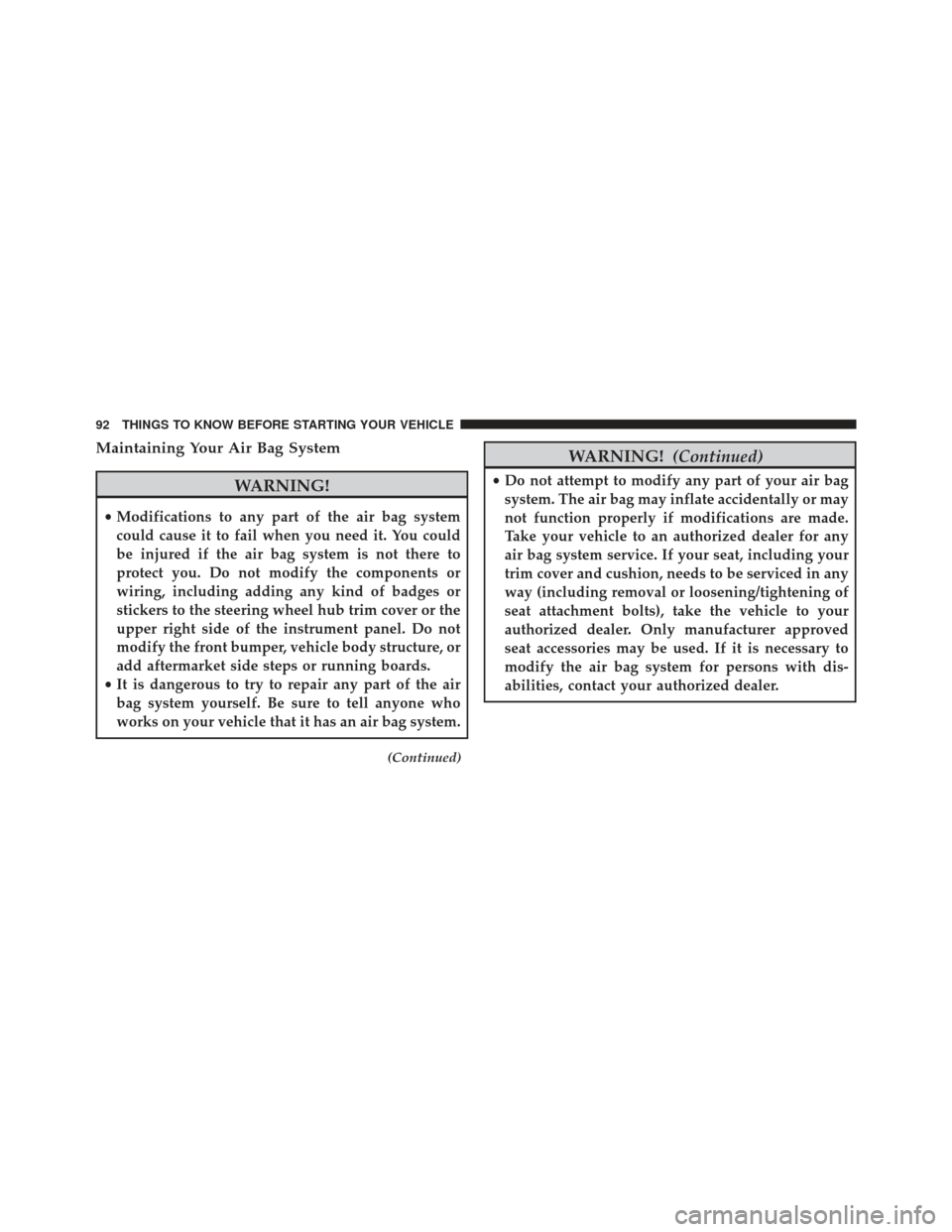
Maintaining Your Air Bag System
WARNING!
•Modifications to any part of the air bag system
could cause it to fail when you need it. You could
be injured if the air bag system is not there to
protect you. Do not modify the components or
wiring, including adding any kind of badges or
stickers to the steering wheel hub trim cover or the
upper right side of the instrument panel. Do not
modify the front bumper, vehicle body structure, or
add aftermarket side steps or running boards.
• It is dangerous to try to repair any part of the air
bag system yourself. Be sure to tell anyone who
works on your vehicle that it has an air bag system.
(Continued)
WARNING! (Continued)
•Do not attempt to modify any part of your air bag
system. The air bag may inflate accidentally or may
not function properly if modifications are made.
Take your vehicle to an authorized dealer for any
air bag system service. If your seat, including your
trim cover and cushion, needs to be serviced in any
way (including removal or loosening/tightening of
seat attachment bolts), take the vehicle to your
authorized dealer. Only manufacturer approved
seat accessories may be used. If it is necessary to
modify the air bag system for persons with dis-
abilities, contact your authorized dealer.
92 THINGS TO KNOW BEFORE STARTING YOUR VEHICLE
Page 95 of 699
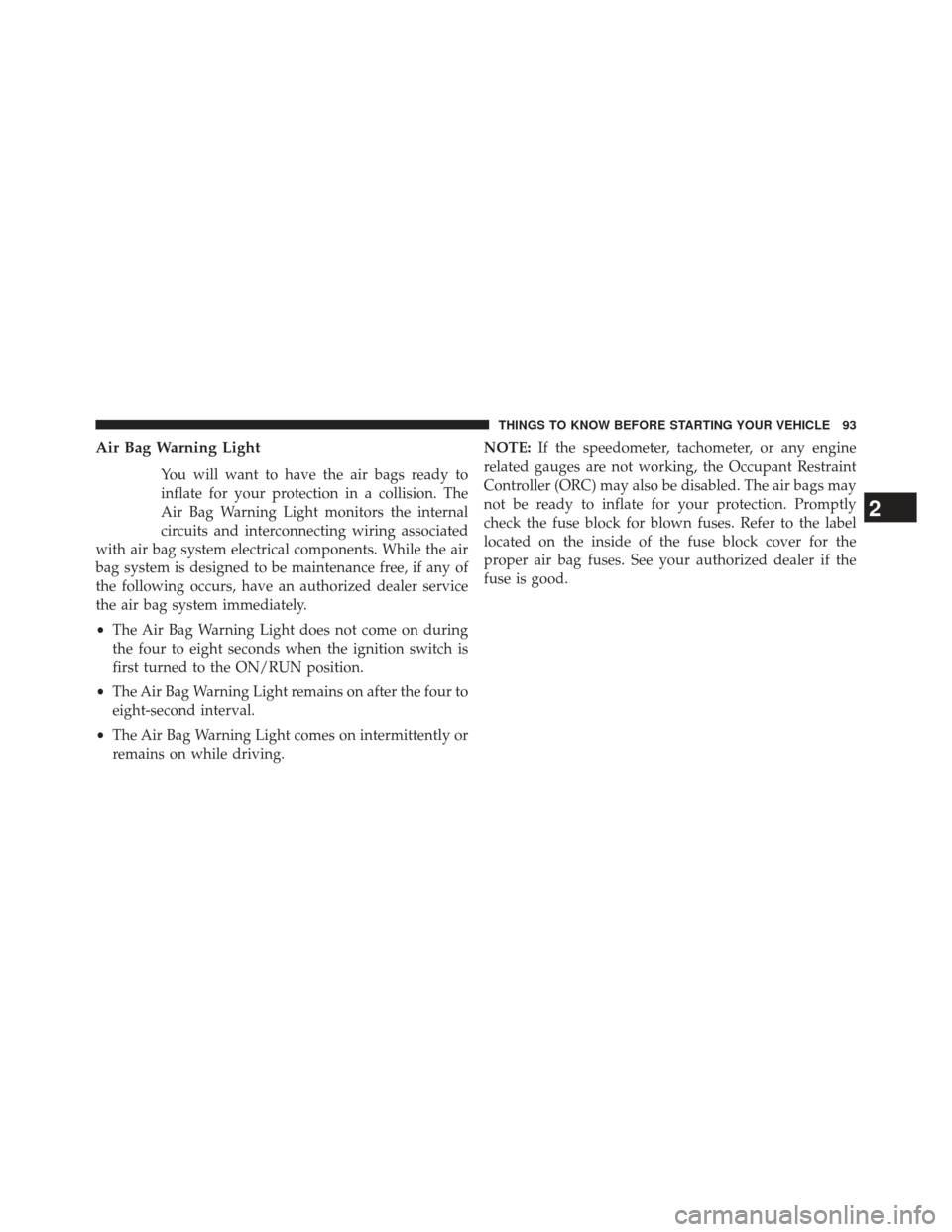
Air Bag Warning Light
You will want to have the air bags ready to
inflate for your protection in a collision. The
Air Bag Warning Light monitors the internal
circuits and interconnecting wiring associated
with air bag system electrical components. While the air
bag system is designed to be maintenance free, if any of
the following occurs, have an authorized dealer service
the air bag system immediately.
• The Air Bag Warning Light does not come on during
the four to eight seconds when the ignition switch is
first turned to the ON/RUN position.
• The Air Bag Warning Light remains on after the four to
eight-second interval.
• The Air Bag Warning Light comes on intermittently or
remains on while driving. NOTE:
If the speedometer, tachometer, or any engine
related gauges are not working, the Occupant Restraint
Controller (ORC) may also be disabled. The air bags may
not be ready to inflate for your protection. Promptly
check the fuse block for blown fuses. Refer to the label
located on the inside of the fuse block cover for the
proper air bag fuses. See your authorized dealer if the
fuse is good.
2
THINGS TO KNOW BEFORE STARTING YOUR VEHICLE 93
Page 565 of 699
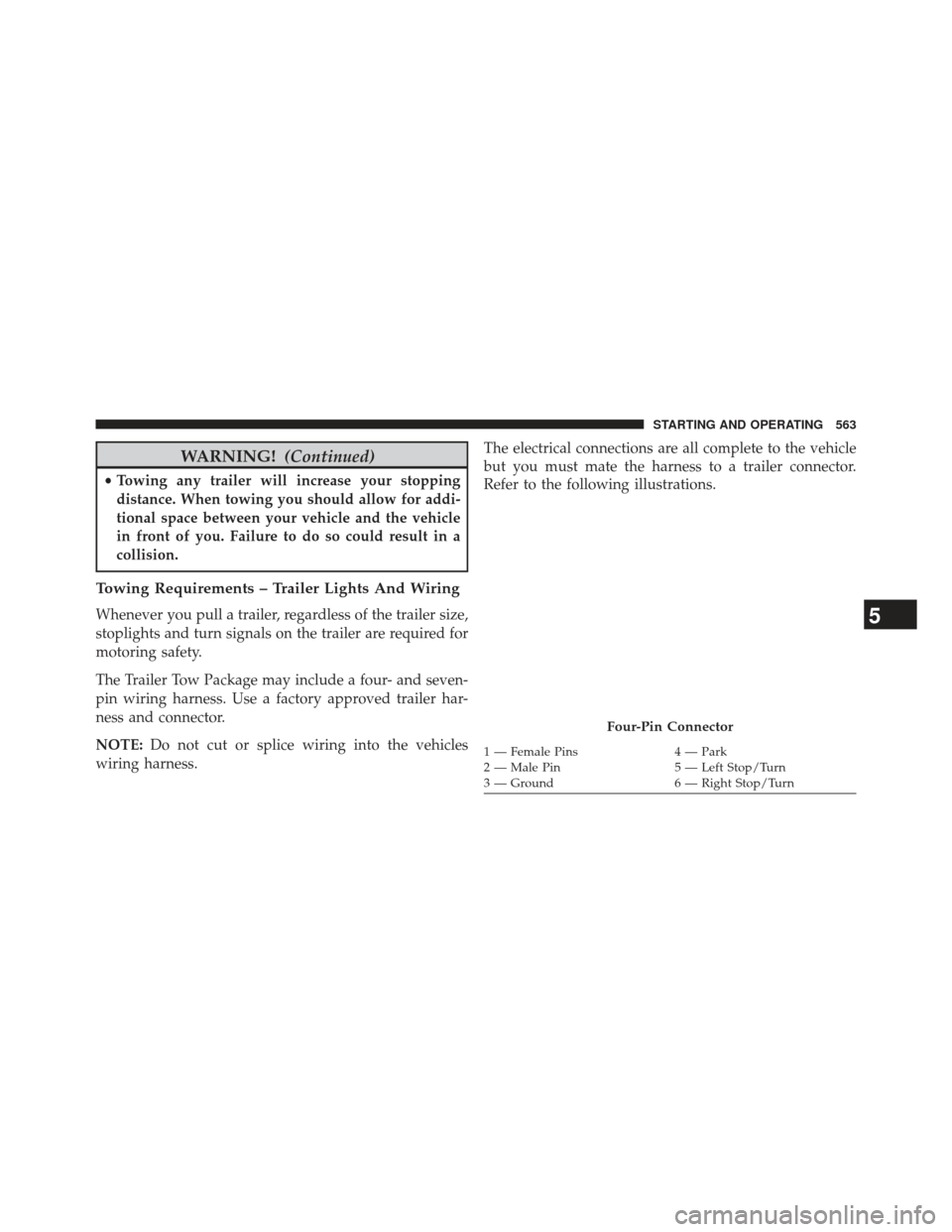
WARNING!(Continued)
•Towing any trailer will increase your stopping
distance. When towing you should allow for addi-
tional space between your vehicle and the vehicle
in front of you. Failure to do so could result in a
collision.
Towing Requirements – Trailer Lights And Wiring
Whenever you pull a trailer, regardless of the trailer size,
stoplights and turn signals on the trailer are required for
motoring safety.
The Trailer Tow Package may include a four- and seven-
pin wiring harness. Use a factory approved trailer har-
ness and connector.
NOTE: Do not cut or splice wiring into the vehicles
wiring harness. The electrical connections are all complete to the vehicle
but you must mate the harness to a trailer connector.
Refer to the following illustrations.
Four-Pin Connector
1 — Female Pins
4 — Park
2 — Male Pin 5 — Left Stop/Turn
3 — Ground 6 — Right Stop/Turn
5
STARTING AND OPERATING 563
Page 651 of 699
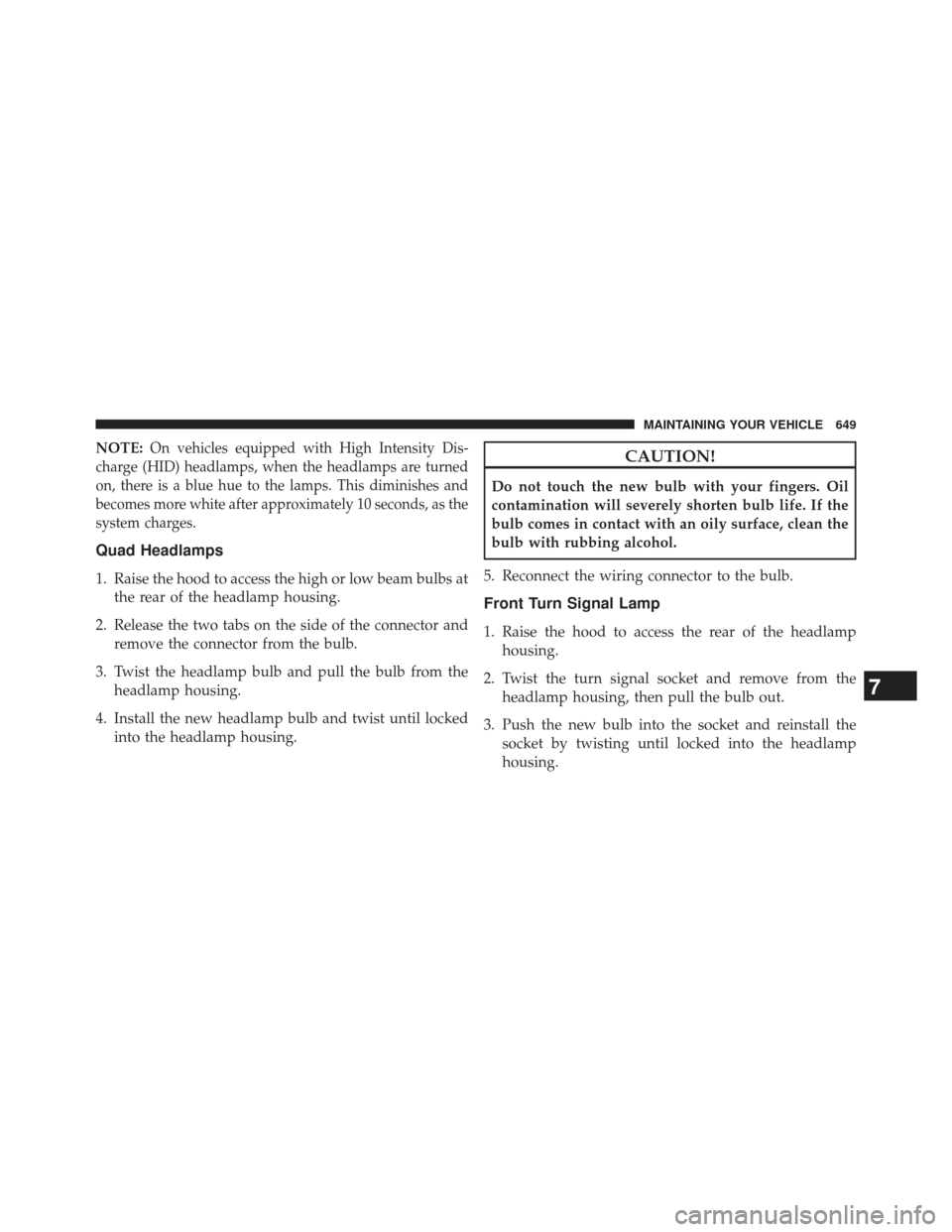
NOTE:On vehicles equipped with High Intensity Dis-
charge (HID) headlamps, when the headlamps are turned
on, there is a blue hue to the lamps. This diminishes and
becomes more white after approximately 10 seconds, as the
system charges.
Quad Headlamps
1. Raise the hood to access the high or low beam bulbs at the rear of the headlamp housing.
2. Release the two tabs on the side of the connector and remove the connector from the bulb.
3. Twist the headlamp bulb and pull the bulb from the headlamp housing.
4. Install the new headlamp bulb and twist until locked into the headlamp housing.
CAUTION!
Do not touch the new bulb with your fingers. Oil
contamination will severely shorten bulb life. If the
bulb comes in contact with an oily surface, clean the
bulb with rubbing alcohol.
5. Reconnect the wiring connector to the bulb.
Front Turn Signal Lamp
1. Raise the hood to access the rear of the headlamp housing.
2. Twist the turn signal socket and remove from the headlamp housing, then pull the bulb out.
3. Push the new bulb into the socket and reinstall the socket by twisting until locked into the headlamp
housing.
7
MAINTAINING YOUR VEHICLE 649
Page 652 of 699
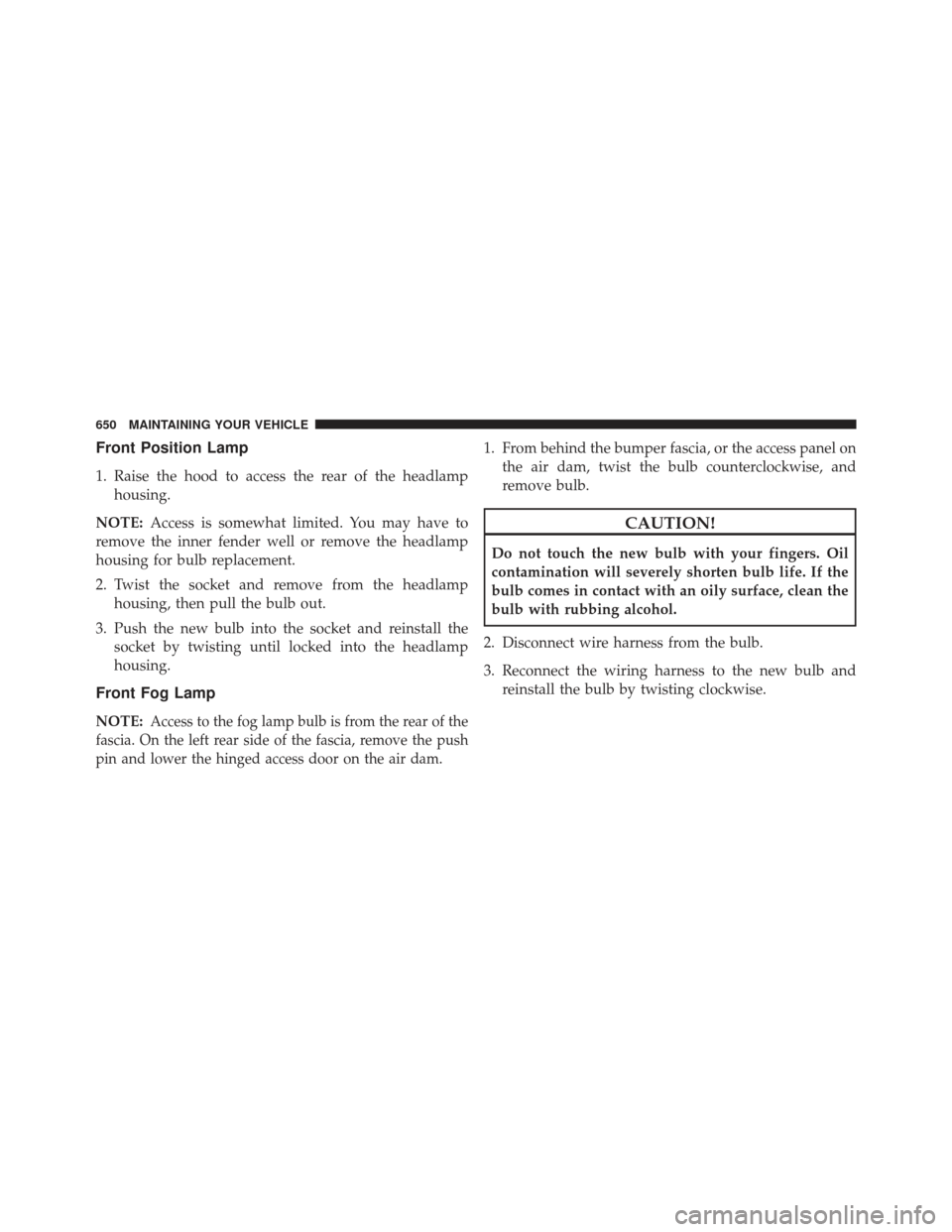
Front Position Lamp
1. Raise the hood to access the rear of the headlamphousing.
NOTE: Access is somewhat limited. You may have to
remove the inner fender well or remove the headlamp
housing for bulb replacement.
2. Twist the socket and remove from the headlamp housing, then pull the bulb out.
3. Push the new bulb into the socket and reinstall the socket by twisting until locked into the headlamp
housing.
Front Fog Lamp
NOTE:Access to the fog lamp bulb is from the rear of the
fascia. On the left rear side of the fascia, remove the push
pin and lower the hinged access door on the air dam.
1. From behind the bumper fascia, or the access panel on the air dam, twist the bulb counterclockwise, and
remove bulb.
CAUTION!
Do not touch the new bulb with your fingers. Oil
contamination will severely shorten bulb life. If the
bulb comes in contact with an oily surface, clean the
bulb with rubbing alcohol.
2. Disconnect wire harness from the bulb.
3. Reconnect the wiring harness to the new bulb and reinstall the bulb by twisting clockwise.
650 MAINTAINING YOUR VEHICLE
Page 696 of 699
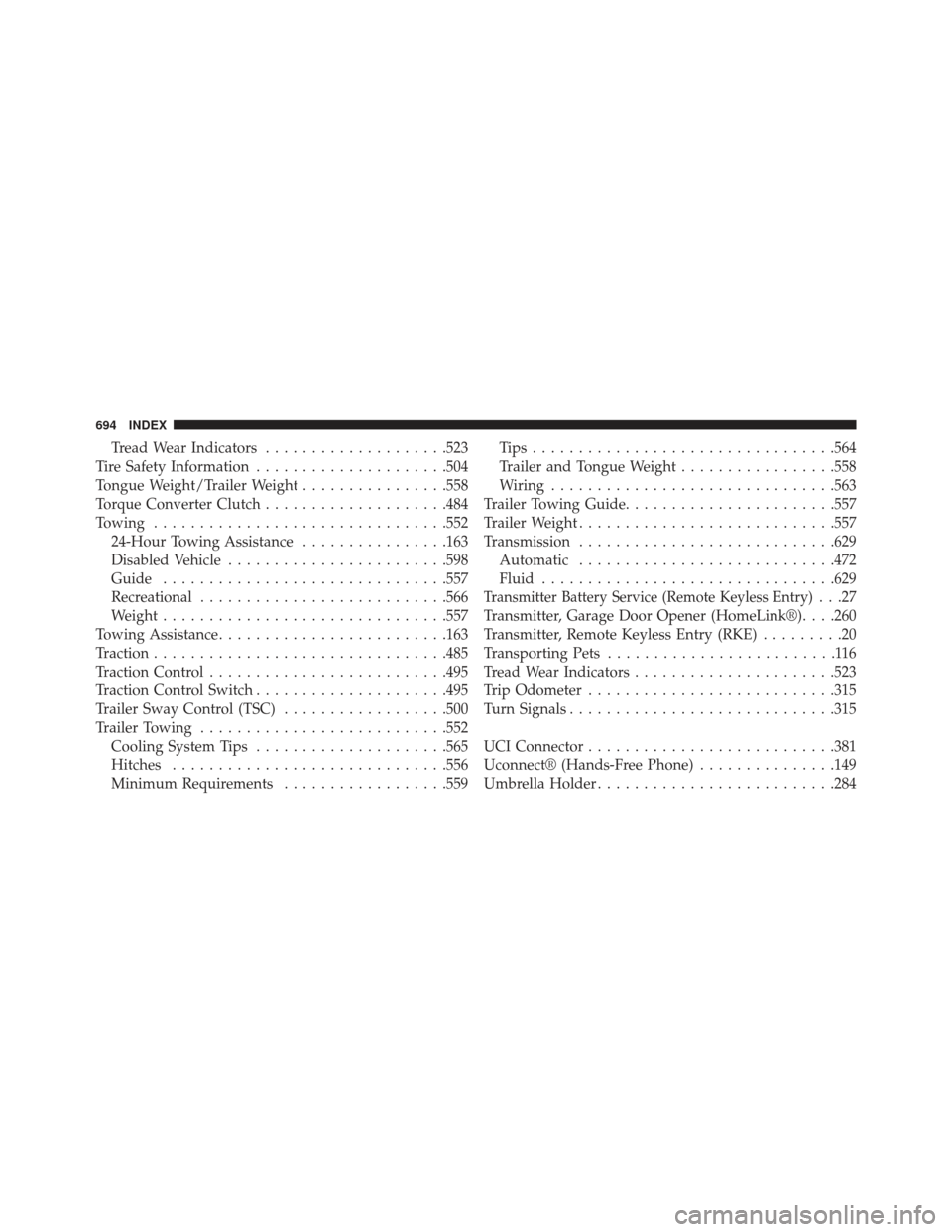
Tread Wear Indicators....................523
Tire Safety Information .....................504
Tongue Weight/Trailer Weight ................558
Torque Converter Clutch ....................484
Towing ............................... .552
24-Hour Towing Assistance ................163
Disabled Vehicle ....................... .598
Guide .............................. .557
Recreational .......................... .566
Weight .............................. .557
Towing Assistance ........................ .163
Traction ............................... .485
Traction Control ......................... .495
Traction Control Switch .....................495
Trailer Sway Control (TSC) ..................500
Trailer Towing .......................... .552
Cooling System Tips .....................565
Hitches ............................. .556
Minimum Requirements ..................559 Tips................................
.564
Trailer and Tongue Weight .................558
Wiring .............................. .563
Trailer Towing Guide ...................... .557
Trailer Weight ........................... .557
Transmission ........................... .629
Automatic ........................... .472
Fluid ............................... .629
Transmitter Battery Service (Remote Keyless Entry). . .27
Transmitter, Garage Door Opener (HomeLink®). . . .260
Transmitter, Remote Keyless Entry (RKE) .........20
Transporting Pets .........................116
Tread Wear Indicators ..................... .523
Trip Odometer .......................... .315
Turn Signals ............................ .315
UCI Connector .......................... .381
Uconnect® (Hands-Free Phone) ...............149
Umbrella Holder ......................... .284
694 INDEX
Page 698 of 699
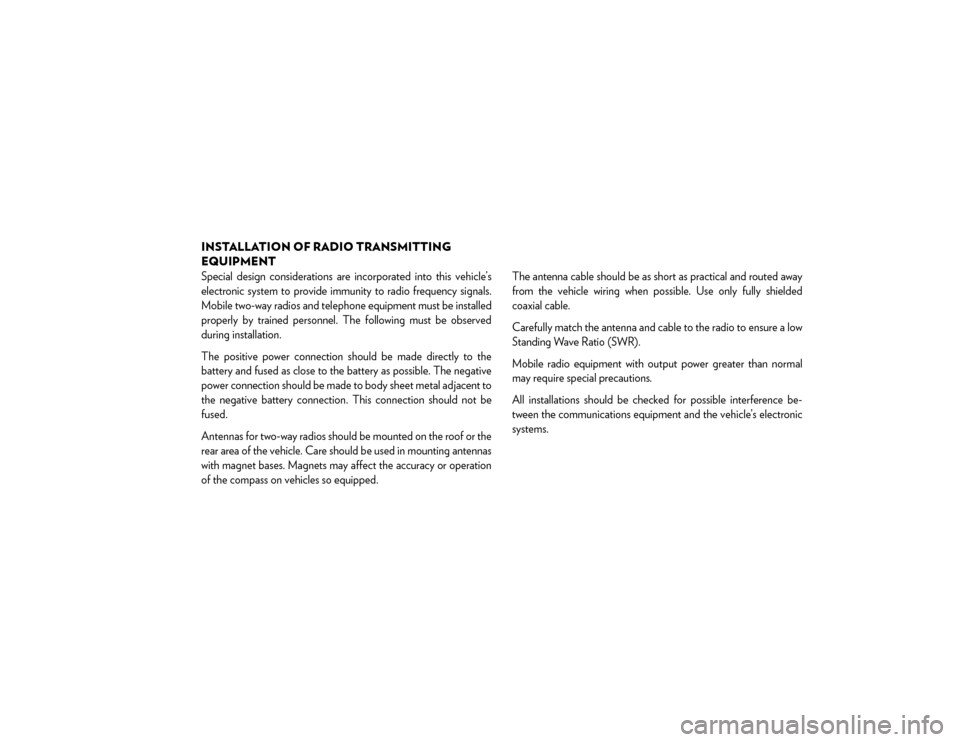
INSTALLATION OF RADIO TRANSMITTING
EQUIPMENTSpecial design considerations are incorporated into this vehicle’s
electronic system to provide immunity to radio frequency signals.
Mobile two-way radios and telephone equipment must be installed
properly by trained personnel. The following must be observed
during installation.
The positive power connection should be made directly to the
battery and fused as close to the battery as possible. The negative
power connection should be made to body sheet metal adjacent to
the negative battery connection. This connection should not be
fused.
Antennas for two-way radios should be mounted on the roof or the
rear area of the vehicle. Care should be used in mounting antennas
with magnet bases. Magnets may affect the accuracy or operation
of the compass on vehicles so equipped.The antenna cable should be as short as practical and routed away
from the vehicle wiring when possible. Use only fully shielded
coaxial cable.
Carefully match the antenna and cable to the radio to ensure a low
Standing Wave Ratio (SWR).
Mobile radio equipment with output power greater than normal
may require special precautions.
All installations should be checked for possible interference be-
tween the communications equipment and the vehicle’s electronic
systems.